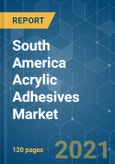South America acrylic adhesives market is expected to grow at a CAGR of over 3.5% during the forecast period. The demand for acrylic adhesives is widely driven by the recovery in construction activities and high dependency on processed and packaged food products. However, stringent VOC emission regulations related to acrylic adhesives disposal and/or substitution from different feedstock may hinder the growth of the studied market.
Key Market Trends
Packaging Industry to Drive the Market Demand
Brazil to Dominate the Market
Competitive Landscape
South America acrylic adhesives market is fragmented in nature. Some of the key players in the market includes 3M, Arkema Group, Sika AG, H.B. Fuller, and Henkel AG & Co. KGaA, amongst others.
Reasons to Purchase this report:
This product will be delivered within 2 business days.
- The water-based acrylic adhesives segment is expected to be the fastest growing segment, owing to the increasing consumer awareness about the ill-effects of solvent-based adhesives on environment and human health.
- Replacement of solvent-borne adhesives in construction industry and shifting focus towards the bio-based adhesives are likely to offer opportunities for the acrylic adhesives market in the region.
- Brazil stands to be the largest market for acrylic adhesives in the region, with consumption being majorly driven by the growth in construction, woodworking and packaging industries.
Key Market Trends
Packaging Industry to Drive the Market Demand
- The packaging industry dominates the consumption of acrylic adhesives, as they are widely useful in the manufacturing of various products, such as tapes, cases, labels, and cartons.
- In South America, countries such as Brazil, Chile and Argentina have strong dependency on processed and packaged food.
- Further, growing e-commerce, online food deliveries, and innovation and development related to product packaging have been influencing the demand for packaging materials in the region.
- Hence, all such trends influencing the demand for packaging materials are further increasing the consumption of acrylic adhesives in packaging industry.
Brazil to Dominate the Market
- In terms of consumption, Brazil stands to be the largest market for contact adhesive in the region. Brazil had experienced a volatile economy over the past few years.
- Political instability, high inflation, low prices of export of goods, and depressed confidence levels caused a contraction in the Brazilian economy.
- However, the country’s economic growth is now supported by the recovery in various end-user industries, such as automotive and construction.
- Currently, the country’s infrastructure sector is under flux. However, the government has introduced a program for infrastructure development to help leverage private sector logistics investment, which is likely to increase the scope for consumption of acrylic adhesive market in the country during the forecast period.
- Brazil retail sector stands to be the largest in the region which accounts for more than 35% of the regional retail sales. The sector is further witnessing noticeable growth in the country with growing demand for food and consumer goods.
- Thus, with such trends in retail sector, the demand for packaging as well as acrylic adhesives is anticipated to increase in the country over the forecast period.
Competitive Landscape
South America acrylic adhesives market is fragmented in nature. Some of the key players in the market includes 3M, Arkema Group, Sika AG, H.B. Fuller, and Henkel AG & Co. KGaA, amongst others.
Reasons to Purchase this report:
- The market estimate (ME) sheet in Excel format
- 3 months of analyst support
This product will be delivered within 2 business days.
Table of Contents
1 INTRODUCTION
4 MARKET DYNAMICS
5 MARKET SEGMENTATION
6 COMPETITIVE LANDSCAPE
7 MARKET OPPORTUNITIES AND FUTURE TRENDS
Companies Mentioned (Partial List)
A selection of companies mentioned in this report includes, but is not limited to:
- 3M
- Adhesives Research Inc.
- Arkema Group
- Ashland
- Avery Dennison Corporation
- Beardow Adams
- Dow
- DuPont
- Dymax Corporation
- H.B. Fuller
- Henkel AG & Co. KGaA
- Hexion
- Huntsman International LLC
- ITW Performance Polymers (Illinois Tool Works Inc.)
- Jowat AG
- Mapei Inc.
- Tesa SE (A Beiersdorf Company)
- Sika AG
- Wacker Chemie AG
Methodology

LOADING...








